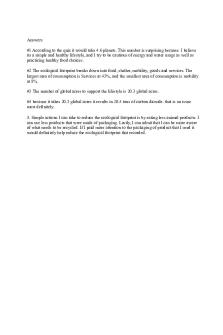Ecological succession lab PDF

| Title | Ecological succession lab |
|---|---|
| Author | Kade Heddings |
| Course | Biotechnology |
| Institution | Northern Arizona University |
| Pages | 5 |
| File Size | 184.8 KB |
| File Type | |
| Total Downloads | 60 |
| Total Views | 144 |
Summary
Download Ecological succession lab PDF
Description
Environmental Succession Pre-Lab Questions 1. How do ecosystems change over time? What causes those changes to occur? Include a specific example in your answer.
Ecosystems change over time, especially after disturbances, as some species die and new species move in.
2. Identify three critical factors (abiotic or biotic) required for primary succession to occur.
Rock formation, lichen, no organisms or soil, wind, water.
3. Give two reasons why ecological succession progresses from populations with low diversity to populations with high diversity. Populations with low diversity are typically less stable.
4. Highly diverse ecosystems are often regarded as more “healthy.” Explain why.
More resources are available for the organisms living in the ecosystem. 5. How does ecological succession demonstrate the evolutionary process of “survival of the fittest”? It demonstrates this process because the organisms that are able to adapt to the changing environment around them, are the ones that survive.
Experiment 1: Winogradsky Column Data Tables Table 1: Winogradsky Column Results
Week #
Observations (colors, layers, etc.)
1 2 3 4 5 6 7 8 9 10
Post- Lab Questions 1. State a detailed conclusion based on your observation of the Winogradsky column. What types of species do you think you observed? Do your results support the hypothesis? Be specific and detailed in your answer.
2. Which part of the column is aerobic? Which part is anaerobic? How does oxygen affect the type of bacteria found in the column?
3. How many kingdoms do you believe are represented in the ecosystem in your bottle? Explain
4. What methods could you use to determine the types of microorganisms found in your column?
5. Where does carbon come from in a Winogradsky column?
6. Why is carbon important?
7. What purpose does calcium sulfate serve in the Winogradsky column?
8. How is photosynthesis different between cyanobacteria (growing at the top of the column) and green and purple sulfur bacteria (growing near the bottom 1/3 of the column)?
Experiment 2: Succession Observations in the Field Data Tables Insert your picture or drawing here:
Post Lab Questions 1. What type of ecosystem was originally found in this location? What type of ecosystem is still found in the surrounding area? The type of ecosystem that was originally in this location is a forest and the surrounding ecosystem is forest.
2. What type of disturbance happened? How large is the disturbed area? Approximately how long ago do you believe this disturbance happened? The type of disturbance would be a human disturbance, by creating a trail.
3. What species do you observe in the location? Try naming as many as you can, use a field guide or the internet to help with identification. I observed many crows and different species of birds. There were also squirrels and different types of insects.
4. What is the definition of pioneer species? Did you observe any pioneer species? Pioneer are organisms often lichen, that colonize barren rock or lava during primary succession & help in the development of soil so other organisms may follow population. There was some lichen on rocks in the area.
5. Would you classify this as primary or secondary succession? Explain. This would be secondary succession because not everything in the ecosystem was destroyed. There is still plenty of life present.
6. How far along is succession in this area? If newly disturbed is 0 and the original ecosystem is 100, what number would you give the location today? Do you believe it is likely that this area will recover to the original ecosystem? Why or why not? I would give it an 80, not too much of the environment is affected and it could make a full recovery....
Similar Free PDFs

Ecological succession lab
- 5 Pages

Ecological Succession
- 4 Pages

Ecological Succession
- 5 Pages

Ecological Succession Worksheet
- 3 Pages

Primary Ecological Succession
- 2 Pages

Ecological footprint
- 1 Pages

State Succession
- 13 Pages

Ecological Footprint Worksheet
- 2 Pages

23 Ecological Relationships-S
- 8 Pages

23322160-Tables-Succession
- 6 Pages

Intestate Succession Act
- 5 Pages
Popular Institutions
- Tinajero National High School - Annex
- Politeknik Caltex Riau
- Yokohama City University
- SGT University
- University of Al-Qadisiyah
- Divine Word College of Vigan
- Techniek College Rotterdam
- Universidade de Santiago
- Universiti Teknologi MARA Cawangan Johor Kampus Pasir Gudang
- Poltekkes Kemenkes Yogyakarta
- Baguio City National High School
- Colegio san marcos
- preparatoria uno
- Centro de Bachillerato Tecnológico Industrial y de Servicios No. 107
- Dalian Maritime University
- Quang Trung Secondary School
- Colegio Tecnológico en Informática
- Corporación Regional de Educación Superior
- Grupo CEDVA
- Dar Al Uloom University
- Centro de Estudios Preuniversitarios de la Universidad Nacional de Ingeniería
- 上智大学
- Aakash International School, Nuna Majara
- San Felipe Neri Catholic School
- Kang Chiao International School - New Taipei City
- Misamis Occidental National High School
- Institución Educativa Escuela Normal Juan Ladrilleros
- Kolehiyo ng Pantukan
- Batanes State College
- Instituto Continental
- Sekolah Menengah Kejuruan Kesehatan Kaltara (Tarakan)
- Colegio de La Inmaculada Concepcion - Cebu




